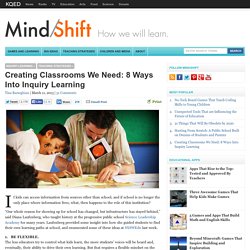

Rubric.pdf. Introduction. 1.

Students learn isolated skills and knowledge, starting with the simple building blocks of a particular topic and then building to more complex ideas. While this appeals to common sense (think of the efficiency of a automobile assembly line), the problem with this approach is the removal of any context to the learning, making deep understanding of the content less likely. Perkins calls this approach elementitis, where learning is structured exclusively around disconnected skills and fragmented pieces of information. 2. Students learn about a particular topic. The solution that Perkins offers to the typical classroom experience is what he calls learning by wholes, structuring learning around opportunities to experience or engage in the topic as it would exist outside of school.
An example of ‘learning by wholes’ can be found in my own Cigar Box Project, a year-long, grade 7 study where students explored 5 themes in Canadian history. Inquiry as “Play” Moving From Theory to Practice. Great Teaching Means Letting Go. Great Teaching Means Letting Go by Grant Wiggins, Ed.D, Authentic Education My greatest learning as a teacher came on the soccer field.

We had been working for a few weeks on the same key ‘moves’ on the field related to creating ‘space’. After a few practices, the team looked good in the drills – they’ve got it! Next two games? There are two vital lessons here about learning: Transfer is the bottom-line goal of all learning, not scripted behavior.Transfer means that a learner can draw upon and apply from allof what was learned, as the situation warrants, not just do one move at a time in response to a prompt. In a word: autonomy. Put negatively, the more coaches and teachers prompt/remind/scaffold, over and over, without a deliberate and explicit plan for release of responsibility, the more students will flounder in situations demanding autonomy.
Everywhere I go I see way too much scaffolded and prompted teaching – through twelfth grade. But, Grant – surely with little kids… No! 1. Chris Lehmann - Inquiry: The Very First Step In the Process of Learning. Chris Lehmann is the founding principal of the Science Leadership Academy (SLA) in Philadelphia, Pennsylvania.

In November of 2012, Chris was named one of Dell's #Inspire100 - one of the 100 people changing the world using Social Media. In April of 2012, Chris won the Lindback Award for Excellence in Principal Leadership in the School District of Philadelphia. In September of 2011, Chris was honored by the White House as a Champion of Change for his work in education reform. SLA is built on the notion that inquiry is the very first step in the process of learning. Developed in partnership with The Franklin Institute and its commitment to inquiry-based science, SLA provides a rigorous, college-preparatory curriculum with a focus on science, technology, mathematics and entrepreneurship. Jump to: Resources | Chat & Group Notes | Questions | Participants. Diana Laufenberg: How to learn? From mistakes. Creating Classrooms We Need: 8 Ways Into Inquiry Learning.
If kids can access information from sources other than school, and if school is no longer the only place where information lives, what, then happens to the role of this institution?

“Our whole reason for showing up for school has changed, but infrastructure has stayed behind,” said Diana Laufenberg, who taught history at the progressive public school Science Leadership Academy for many years. Laufenberg provided some insight into how she guided students to find their own learning paths at school, and enumerated some of these ideas at SXSWEdu last week. 1. BE FLEXIBLE. The less educators try to control what kids learn, the more students’ voices will be heard and, eventually, their ability to drive their own learning. Laufenberg recalled a group of tenacious students who continued to ask permission to focus their video project on the subject of drugs, despite her repeated objections. 2.
Laufenberg’s answer: Get them curious enough in the subject to do research on their own. 3. 4. 5. 6. Learners Should Be Developing Their Own Essential Questions. Having essential questions drive curriculum and learning has become core to many educators’ instructional practices.

Grant Wiggins, in his work on Understanding By Design, describes an essential question as: A meaning of “essential” involves important questions that recur throughout one’s life. Such questions are broad in scope and timeless by nature. They are perpetually arguable – What is justice? Is art a matter of taste or principles? Although essential questions are powerful advance organizers and curriculum drivers, the problem is that the essential questions are typically developed by the educator not the learners.
Jamie McKenzie describes what actually happens in most schools and classrooms in terms of questioning. There have always been plenty of questions in schools, but most of them have come from the teacher, often at the rate of one question every 2-3 seconds. Steve Denning in a Forbes article, Learning To Ask The Right Question, stated: McKenzie (in 1997!)